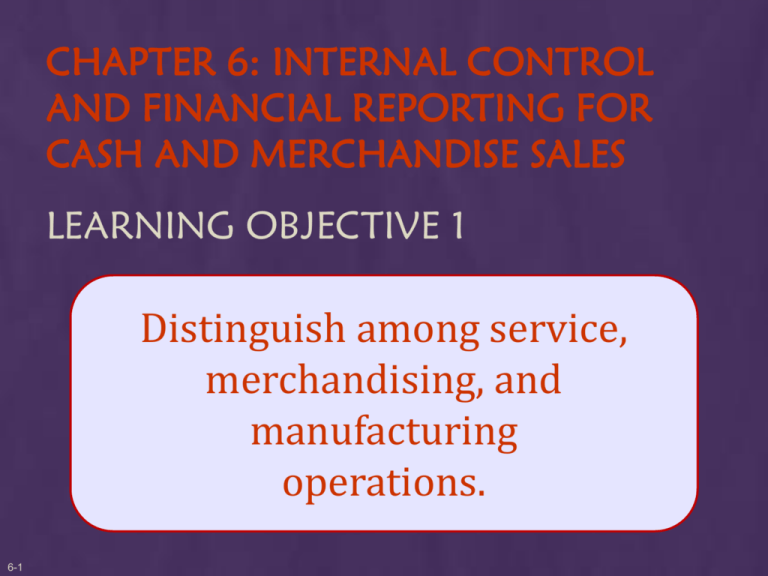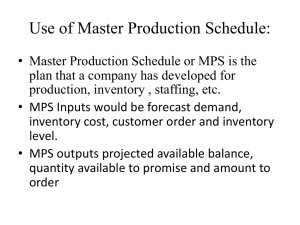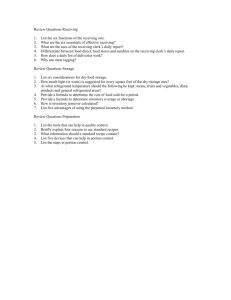internal control and financial reporting for cash and merchandise sales
advertisement

CHAPTER 6: INTERNAL CONTROL AND FINANCIAL REPORTING FOR CASH AND MERCHANDISE SALES LEARNING OBJECTIVE 1 Distinguish among service, merchandising, and manufacturing operations. 6-1 OPERATING CYCLES 6-2 OPERATING CYCLES Sell Products Buy Products Merchandising Company Incur Operating Expenses 6-3 Collect Cash OPERATING CYCLES Sell Products Make Products Buy Raw Materials 6-4 Manufacturing Company Incur Operating Expenses Collect Cash LEARNING OBJECTIVE 2 Explain common principles and limitations of internal control. 6-5 INTERNAL CONTROL All companies include as part of their operating activities a variety of procedures and policies that are referred to as internal controls. Internal controls are the methods a company uses to: 1. Protect against the theft of assets. 2. Enhance the reliability of accounting information. 3. Promote efficient and effective operations. 4. Ensure compliance with applicable laws and regulations. 6-6 COMMON CONTROL PRINCIPLES Principle Establish responsibility Segregate duties Restrict access Document procedures Independently verify 6-7 Explanation Assign each task to only one person. Do not make one employee responsible for all parts of a process. Do not provide access to assets or information unless it is needed to fulfill assigned responsibilities. Prepare documents to show activities that have occurred. Check others' work. Examples Each Wal-Mart cashier uses a different cash drawer Wal-Mart cashiers, who ring up sales, do not approve price changes. Wal-Mart secures valuable assets such as cash and access to its computer systems (passwords, firewalls). Wal-Mart pays suppliers using prenumbered checks. Wal-Mart compares cash balances in its accounting records to the cash balances reported by its bank, and accounts for any differences. CONTROL LIMITATIONS Internal controls can never completely prevent and detect errors and fraud. Benefits vs. Cost 6-8 Human Error or Fraud LEARNING OBJECTIVE 4 Perform the key control of reconciling cash to bank statements. 6-9 BANK PROCEDURES AND RECONCILIATION Banks provide services that help businesses to control cash in several ways: Restricting Access Documenting Procedures Independently Verifying A bank reconciliation is an internal report prepared to verify the accuracy of both the bank statement and the cash accounts of a business or individual. 6-10 BANK STATEMENT 1 2 6-11 3 4 5 RECONCILING DIFFERENCES Your Bank May Not Know About . . . 1. Errors made by the bank. 2. Time lags: a. Deposits that you made recently. b. Checks that you wrote recently. 3. 4. 5. 6. 7. 6-12 You May Not Know About . . . Interest the bank has put into your account. Electronic funds transfer (EFT) Service charges taken out of your account. Customer checks you deposited but that bounced. Errors made by you. BANK RECONCILIATION To determine the appropriate cash balance, these balances need to be reconciled. 6-13 BANK RECONCILIATION Bank Reconciliation Goals 1.Identify the deposits in transit. 2.Identify the outstanding checks. 3.Record other transactions on the bank statement. 4.Determine the impact of errors. 6-14 BANK RECONCILIATION 6-15 REPORTING CASH AND CASH EQUIVALENTS Cash includes money or any instrument that banks will accept for deposit and immediate credit to a company’s account, such as a check, money order, or bank draft. Cash equivalents are short-term, highly liquid investments purchased within three months of maturity. 6-16 LEARNING OBJECTIVE 5 Explain the use of a perpetual inventory system as a control. 6-17 CONTROLLING AND REPORTING MERCHANDISE SALES Inventory Quantities 6-18 Inventory Costs Financial Statements Unsold Inventory Balance Sheet Sold Inventory Income Statement PERPETUAL INVENTORY SYSTEM In a perpetual inventory system, the inventory records are updated “perpetually,” that is, every time inventory is bought, sold, or returned. Perpetual systems often are combined with bar codes and optical scanners. 6-19 PERIODIC INVENTORY SYSTEM In a periodic inventory system, the inventory records are updated “periodically,” that is, at the end of the accounting period. To determine how much merchandise has been sold, periodic systems require that inventory be physically counted at the end of the period. 6-20 INVENTORY CONTROL 6-21 Perpetual Inventory System Periodic Inventory System Continuous Tracking No Up-to-Date Records Can Estimate Shrinkage Can’t Estimate Shrinkage LEARNING OBJECTIVE 6 Analyze sales transactions under a perpetual inventory system. 6-22 SALES TRANSACTIONS Merchandisers earn revenues by transferring ownership of merchandise to a customer, either for cash or on credit. For a merchandiser who is shipping goods to a customer, the transfer of ownership occurs at one of two possible times: 1. FOB shipping point —the sale is recorded when the goods leave the seller’s shipping department. 2. FOB destination —the sale is recorded when the goods reach their destination (the customer). 6-23 SALES TRANSACTIONS Every merchandise sale has two components, each of which requires an entry in a perpetual inventory system. Selling Price Cost 6-24 SALES TRANSACTIONS Assume Wal-Mart sells two Schwinn mountain bikes for $400 cash. The bikes had previously been recorded in Wal-Mart’s Inventory at a total cost of $350. 1 Analyze Assets (a) Cash +400 (b) Inventory -350 2 6-25 Record = Liabilities + Stockholders' Equity Sales Revenue (+R) +400 Cost of Goods Sold (+E) -350 SALES RETURNS AND ALLOWANCES When goods sold to a customer arrive in damaged condition or are otherwise unsatisfactory, the customer can (1) return them for a full refund or (2) keep them and ask for a reduction in the selling price, called an allowance. 6-26 SALES RETURNS AND ALLOWANCES Suppose that after Wal-Mart sold the two Schwinn mountain bikes, the customer returned one to Wal-Mart. Assuming that the bike is still like new, Wal-Mart would refund the $200 selling price to the customer and take the bike back into inventory. 1 Analyze Assets (a) Cash -200 (b) Inventory +175 2 6-27 Record = Liabilities + Stockholders' Equity Sales Returns and Allowances (+xR) -200 Cost of Goods Sold (-E) +175 SALES ON ACCOUNT AND SALES DISCOUNTS A sales discount is a sales price reduction given to customers for prompt payment of their account balance. 6-28 SALES ON ACCOUNT AND SALES DISCOUNTS Suppose Wal-Mart’s warehouse store (Sam’s Club) sells printer paper on account to a local business for $1,000 with payment terms of 2/10, n/30. The paper cost Sam’s Club $700. 1 Analyze Assets (a) Accounts Receivable +1,000 (b) Inventory -700 2 6-29 Record = Liabilities + Stockholders' Equity Sales Revenue (+R) +1,000 Cost of Goods Sold (+E) -700 SALES ON ACCOUNT AND SALES DISCOUNTS To take advantage of this 2% discount, the customer must pay Wal-Mart within 10 days. If the customer does so, it will deduct the $20 discount (2% $1,000) from the total owed ($1,000), and then pay $980 to Wal-Mart. 1 Analyze Assets Cash +980 Accounts Receivable -1,000 2 = Liabilities + Stockholders' Equity Sales Discounts (+xR) -20 Record (2% × $1,000) 6-30 SUMMARY OF SALES-RELATED TRANSACTIONS The sales returns and allowances and sales discounts introduced in this section were recorded using contra-revenue accounts. 6-31 LEARNING OBJECTIVE 7 Analyze a merchandiser’s multistep income statement. 6-32 GROSS PROFIT PERCENTAGE Gross Gross Profit = × 100 Profit % Net Sales 6-33 COMPARING OPERATING RESULTS ACROSS COMPANIES AND INDUSTRIES 6-34





